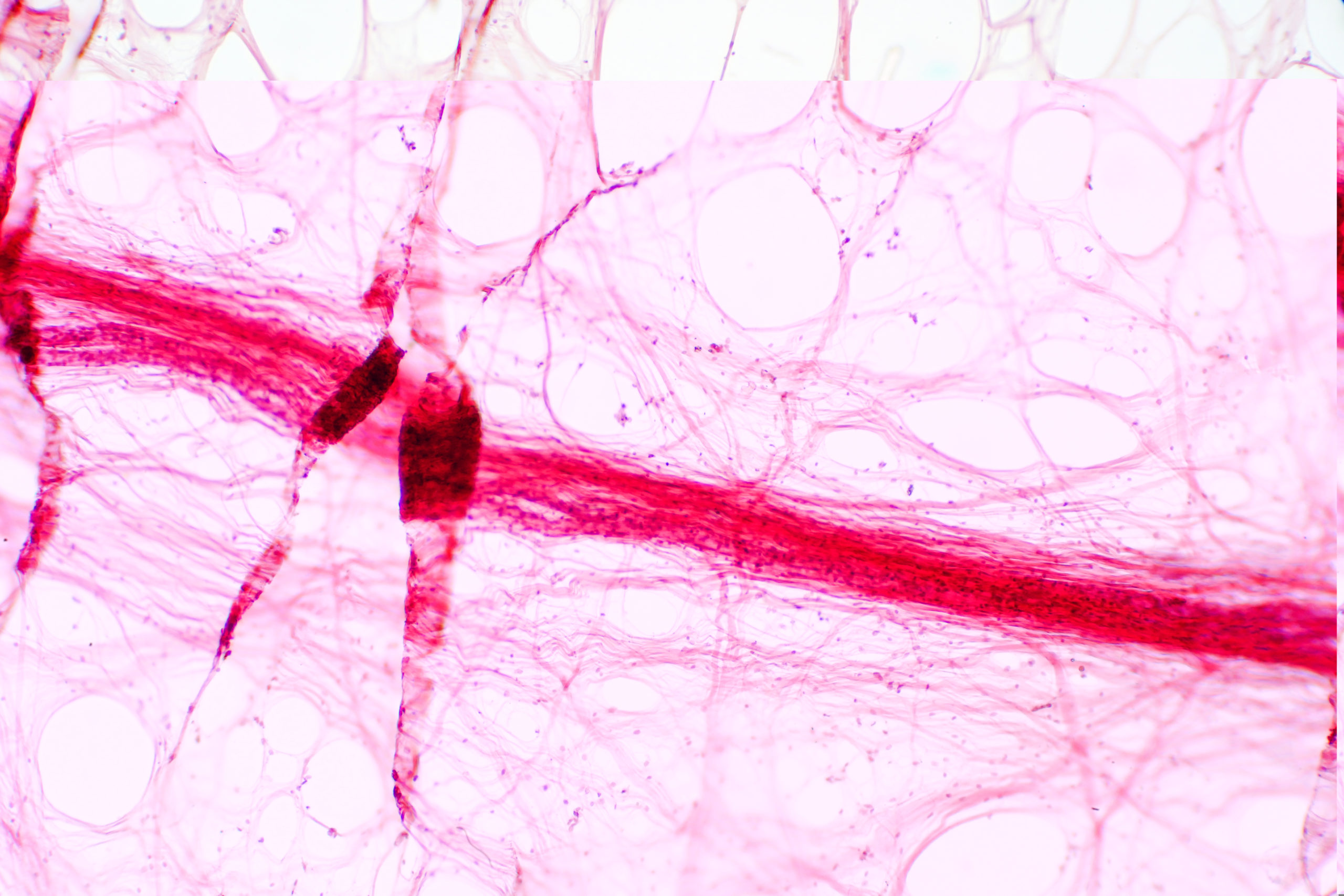In this post, we will explain how tuning fork vibration has such a dramatic effect on the fascia and fluid in the body, why the effects of vibrational fascia release are so dramatic, and what mechanisms are at play. We also respond to several questions about how this form of vibrational therapy corresponds to certain philosophies in the sound healing community when it comes to coherent mechanical input (vibration) being applied to the tissues and whether we believe the specific use of the weighted 128hz tuning fork has a preferred effect on the body.
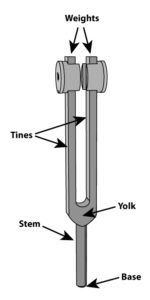 Our philosophy at NEHC Academy is that we do not believe the 128hz weighted tuning fork is more special than any other frequency. However, when it comes to striking the tuning fork and placing it on the body as many times that we do in VFRT or vibrational therapy, the length of the tines and the mechanics of the fork itself creates a greater amplitude or stronger vibration at the base. The mechanics of the weighted tuning fork creates several frequencies beyond just the vibrations of the two tines. The weights create an unbalanced torque to make the entire thing bend, pivot, and twist in several different ways called modes or modals. We happen to dampen most of these modes when we grip the stem of the fork, and the also change the weight distribution when we put attachments on the end. So the frequency of the tuning fork itself is not the key factor in releasing fascia and fluids. It’s the design and weight distribution of the whole fork.
Our philosophy at NEHC Academy is that we do not believe the 128hz weighted tuning fork is more special than any other frequency. However, when it comes to striking the tuning fork and placing it on the body as many times that we do in VFRT or vibrational therapy, the length of the tines and the mechanics of the fork itself creates a greater amplitude or stronger vibration at the base. The mechanics of the weighted tuning fork creates several frequencies beyond just the vibrations of the two tines. The weights create an unbalanced torque to make the entire thing bend, pivot, and twist in several different ways called modes or modals. We happen to dampen most of these modes when we grip the stem of the fork, and the also change the weight distribution when we put attachments on the end. So the frequency of the tuning fork itself is not the key factor in releasing fascia and fluids. It’s the design and weight distribution of the whole fork.
When it comes to coherency, we believe that all of our cells, tissue, organs, and systems have a specific frequency that indicates a healthy system. But each body is unique and the coherent frequency for each of these things can change over time. Our technique does not look to re-establishing the coherency of these parts of the body since there are too many other issues like fluid pockets and fascia restrictions or scars that prevent coherency from being established. We also believe that any attempt to create coherency or entrainment is only temporary as long as the tuning forks are vibrating and pressed against the skin.
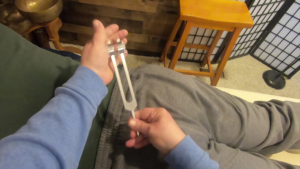 As sound healers, it is our opinion that we over-complicate the process of healing with vibration by looking for some magic frequency to heal specific ailments. The end result is thousands of healers holding tuning forks with no understanding of where to put them or how they work. We have tried to simplify the understanding of the weighted tuning fork into core skills needed to grip the tuning fork correctly, strike it the right way, find the spot underneath the skin that requires attention, and apply the appropriate pressure for the right amount of time so the fluids and fascial adhesions release. If we cannot get these simple things right then we will not have that dramatic effect.
As sound healers, it is our opinion that we over-complicate the process of healing with vibration by looking for some magic frequency to heal specific ailments. The end result is thousands of healers holding tuning forks with no understanding of where to put them or how they work. We have tried to simplify the understanding of the weighted tuning fork into core skills needed to grip the tuning fork correctly, strike it the right way, find the spot underneath the skin that requires attention, and apply the appropriate pressure for the right amount of time so the fluids and fascial adhesions release. If we cannot get these simple things right then we will not have that dramatic effect.
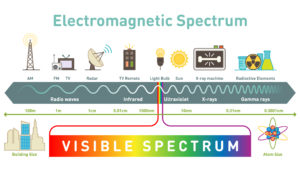 When we consider all vibrations that reach the body, they are not all created equal. Some vibrations are at different strength, and some are in a different form like with radiated energy waves. The physics are different depending on the form the vibration takes to travel. Tuning forks are a form of mechanical energy that uses the physical molecules to travel through a medium form the source to the receiver. Then we must consider the way the receiver processes these vibrations to understand what is needed to communicate using vibrations. For example, our inner ear and auditory system is designed to receive and process a specific range of mechanical vibrations for our brain to process the information into a usable form. Then our visual system uses a different form of electro-magnetic vibration in a very small visible wavelength range. We cannot process visible light energy through our auditory system. Knowing this information, we can apply the same logic to the collagen fascia fibers making up parts of our body like the outer superficial layer just underneath our skin.
When we consider all vibrations that reach the body, they are not all created equal. Some vibrations are at different strength, and some are in a different form like with radiated energy waves. The physics are different depending on the form the vibration takes to travel. Tuning forks are a form of mechanical energy that uses the physical molecules to travel through a medium form the source to the receiver. Then we must consider the way the receiver processes these vibrations to understand what is needed to communicate using vibrations. For example, our inner ear and auditory system is designed to receive and process a specific range of mechanical vibrations for our brain to process the information into a usable form. Then our visual system uses a different form of electro-magnetic vibration in a very small visible wavelength range. We cannot process visible light energy through our auditory system. Knowing this information, we can apply the same logic to the collagen fascia fibers making up parts of our body like the outer superficial layer just underneath our skin.
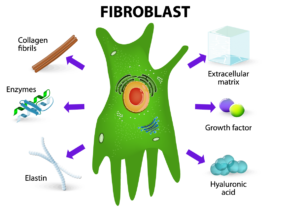 The fascia fibers and the controlling cells that made them (fibroblasts) communicate in different ways depending on the information and speed in which data is needed. Some communication is passed mechanically through tension on the fibers, some communication is passed through electro-magnetic form from the brain and from outside the body. It is the mechanical tension and vibration where we entire this picture with our weighted tuning forks. There have been many discoveries over the past few years from the fascia researchers where we now know that cells require a stretching action AND vibration to cause a dramatic change to the current actions. Basically, these two things are needed to change the currently running program to something else.
The fascia fibers and the controlling cells that made them (fibroblasts) communicate in different ways depending on the information and speed in which data is needed. Some communication is passed mechanically through tension on the fibers, some communication is passed through electro-magnetic form from the brain and from outside the body. It is the mechanical tension and vibration where we entire this picture with our weighted tuning forks. There have been many discoveries over the past few years from the fascia researchers where we now know that cells require a stretching action AND vibration to cause a dramatic change to the current actions. Basically, these two things are needed to change the currently running program to something else.
If we are looking at the surface of a cell, the action of deforming the cell causes the inside mechanisms to look for a new command. It is here that the frequency matters as a specific command to the cell for it’s new action. In the world of computer programming, we recognize this action as we code our software to act upon a repeated command by some input instead of acting on each input independently. Our cells cannot possible respond to a different command each time we move, so there must be a time factor involved in changing the currently running program. It is the 128 times per second AND the stretching of the fascia fibers with the pressure of the tuning fork base that is the mechanism at play to provide such a dramatic effect. Both are needed for a specific amount of time to create an instant change.
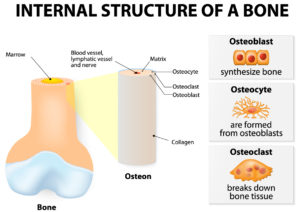 Our body has mechanisms to create structures and remove what is created (or damaged). In our bones, the osteoblast cells produce more structure to create more density based on prolonged pressure from a specific angle on the bone. Then the osteoclast cells remove the structure when there is no longer a prolonged need for strength of structure in that area. Fascia works the same way. There is a structure building mechanism and also a corresponding mechanism to remove the same structure. It is our theory that the combination of the pressure on the fascia fibers in a given area (stretch) and the repeated command of 128 times per second is enough to trigger the fibers to “dissolve” for lack of a better term.
Our body has mechanisms to create structures and remove what is created (or damaged). In our bones, the osteoblast cells produce more structure to create more density based on prolonged pressure from a specific angle on the bone. Then the osteoclast cells remove the structure when there is no longer a prolonged need for strength of structure in that area. Fascia works the same way. There is a structure building mechanism and also a corresponding mechanism to remove the same structure. It is our theory that the combination of the pressure on the fascia fibers in a given area (stretch) and the repeated command of 128 times per second is enough to trigger the fibers to “dissolve” for lack of a better term.
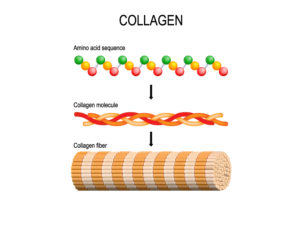 We are only just now starting to really understand the mechanisms of the fascial structure including the fibroblasts. We know there is such a mechanism for dissolving the fibers, and fascia researchers are discovering substances released by the fibroblast cells to dissolve collagen back into its original amino acids. These cells are likely to be termed “fibroclasts” at some point in the future. So this comment presented the physical mechanisms involved in the relationship between tuning forks and fascia. It a minimum, however, vibration also relaxes the tension on the fibers and causes something to happen with the fluids created by the fibroblasts.
We are only just now starting to really understand the mechanisms of the fascial structure including the fibroblasts. We know there is such a mechanism for dissolving the fibers, and fascia researchers are discovering substances released by the fibroblast cells to dissolve collagen back into its original amino acids. These cells are likely to be termed “fibroclasts” at some point in the future. So this comment presented the physical mechanisms involved in the relationship between tuning forks and fascia. It a minimum, however, vibration also relaxes the tension on the fibers and causes something to happen with the fluids created by the fibroblasts.
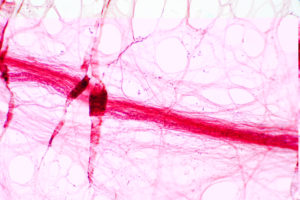 When it comes to the dramatic effects of the fluids associated with the fascia, we must recognize the different fluids. There is a hyaluronic acid that permeates the fascia fibers. It’s used for hydration and lubrication of sliding surfaces. Sometimes we just refer to this fluid as “water”. Then there is the interstitial fluids that run through the extra-cellular structure created by the collagen fascia fibers. This fluid is the plasma coming out of the artery walls and capillaries. Interstitial fluid is usually what I am referencing when I speak of fluid pressurization and pockets trapped by fascia fibers. The pressure creates problems with the structure of the fascia and presses against the vessels and nerves running through the space. Then we have to consider the proteoglycan gel that the fibroblasts create to control the flow of interstitial fluid by slowing it down for the cells to grab the necessary substances from the plasma as it slowly works its way through the “snotty” gel.
When it comes to the dramatic effects of the fluids associated with the fascia, we must recognize the different fluids. There is a hyaluronic acid that permeates the fascia fibers. It’s used for hydration and lubrication of sliding surfaces. Sometimes we just refer to this fluid as “water”. Then there is the interstitial fluids that run through the extra-cellular structure created by the collagen fascia fibers. This fluid is the plasma coming out of the artery walls and capillaries. Interstitial fluid is usually what I am referencing when I speak of fluid pressurization and pockets trapped by fascia fibers. The pressure creates problems with the structure of the fascia and presses against the vessels and nerves running through the space. Then we have to consider the proteoglycan gel that the fibroblasts create to control the flow of interstitial fluid by slowing it down for the cells to grab the necessary substances from the plasma as it slowly works its way through the “snotty” gel.
The fascia fibers and the gel work together to not only control fluid flow, it is used to quarantine any foreign or toxic substances in the interstitial space. This compartmentalization of substances creates un-necessary pressurized spaces that remain underneath our skin forever. Eventually the quarantined areas turn into chronic conditions including neuropathy, joint pain, lack of mobility, organ failure, and eventually cancer when the quarantine lasts long enough.
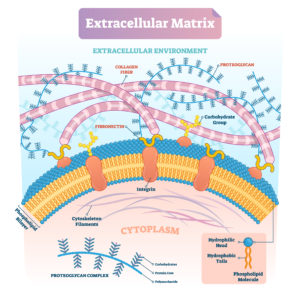 Regional quarantine is actually called edema, although this same localized edema is happening on a smaller scale all throughout our body in the form of compartmentalization of fluids. So here is where the tuning forks come into play again. The gel created by fibroblasts has a thixotropic property. This means the gel can change its viscosity when shaken. Vasoline and catsup are also thixotropic gels that change to a watery consistency when shaken. Now imagine this dramatic effect of both the gel turning into watery liquid while the fascia fibers are vibrated enough to loosen the tension (at a minimum) and fluid pressure releases immediately. These are the mechanisms at play with using a 128hz weighted tuning fork on the body as we use them in Vibrational Fascia Release Technique (TM).
Regional quarantine is actually called edema, although this same localized edema is happening on a smaller scale all throughout our body in the form of compartmentalization of fluids. So here is where the tuning forks come into play again. The gel created by fibroblasts has a thixotropic property. This means the gel can change its viscosity when shaken. Vasoline and catsup are also thixotropic gels that change to a watery consistency when shaken. Now imagine this dramatic effect of both the gel turning into watery liquid while the fascia fibers are vibrated enough to loosen the tension (at a minimum) and fluid pressure releases immediately. These are the mechanisms at play with using a 128hz weighted tuning fork on the body as we use them in Vibrational Fascia Release Technique (TM).

